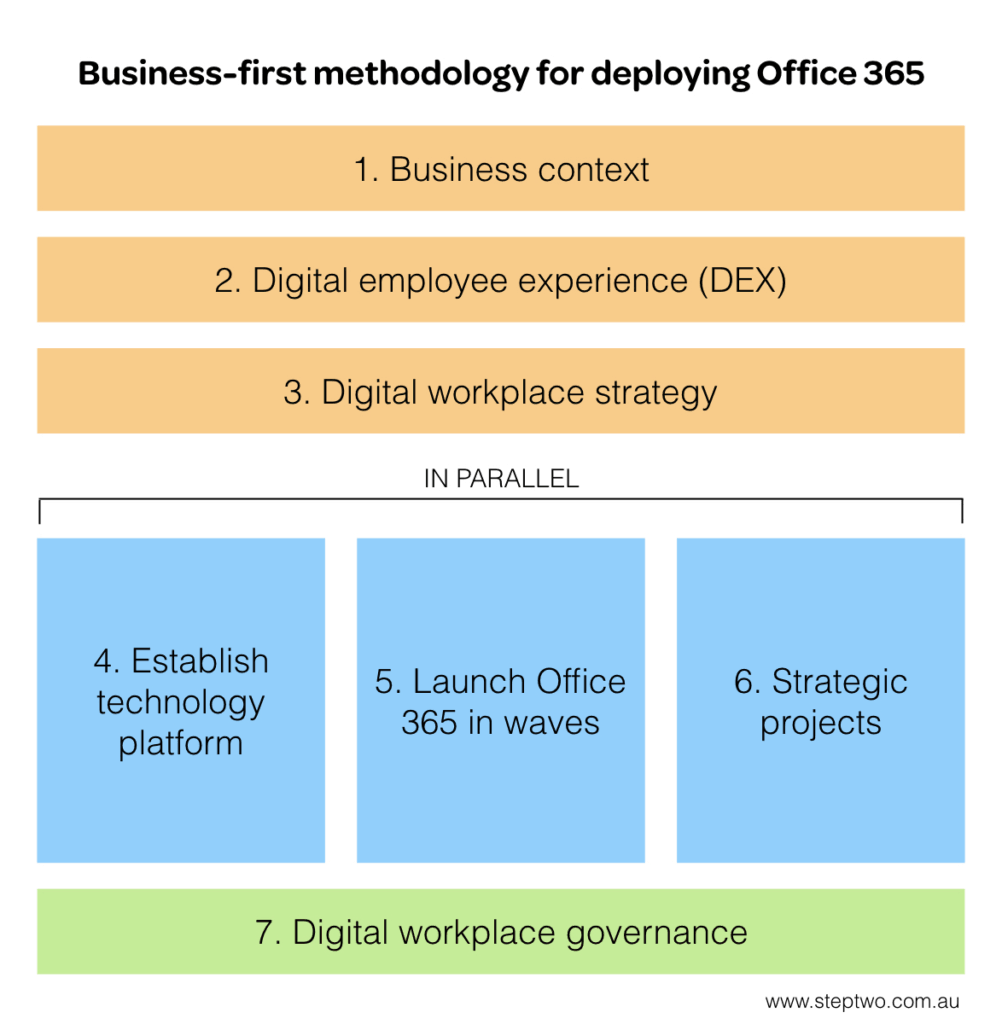
Filed under: Microsoft 365
Office 365 delivers a huge portfolio of tools and capabilities into organisations, but these are only of value if they are used by staff in productive ways. Already it’s clear that a purely organic approach to adoption doesn’t deliver enough benefits to justify the introduction of Office. Yet it hasn’t been clear what a strategic approach to the platform looks like in reality.
To address these uncertainties, Step Two developed the business-first methodology for Office 365, which provides a methodology for successfully introducing the platform into an organisation.

While this gives a very structured approach, the overall methodology can be daunting. It’s therefore worth highlighting that two approaches can be taken to this methodology: a strategic program of work or a series of tactical actions. This article outlines these two approaches.
A strategic approach to Office 365 success

The starting point for any meaningful project that’s aiming to improve the way work is done is to understand the business context. This involves spending time with staff — particularly those in operational and frontline roles — as well as discussing business needs with stakeholders.
The full methodology then unfolds:
- An overall vision and strategy is developed for the rollout of Office 365, with engagement and endorsement of key stakeholders.
- A series of waves (either people waves or technology waves) roll out specific Office 365 capabilities to targeted groups of staff.
- In parallel, strategic projects deliver major updates to key elements of the digital workplace, such as the intranet, or document management practices.
It’s worth highlighting that as per the diagram, this is an ongoing journey without a short-term end point. Cultural and behavioural changes needed for Office 365 success will take time, and the platform itself is constantly being updated.
Taking this top-down strategic approach to Office 365 delivers the greatest benefits, but it also demands the greatest upfront investment in time and effort. It’s not, however, the only approach that can be taken…
A tactical approach to Office 365 success

In many cases, organisations may not have the readiness or resources to jump straight into a truly strategic approach. In these situations, a more pragmatic and tactical approach can be taken.
The starting point is still to understand the business context, including staff needs and stakeholder priorities.
The approach is then to find opportunities to deliver early value from Office 365:
- Identify key needs or specific groups of staff that can be better supported using Office 365.
- Run a series of waves (again, either people waves or technology waves) to meet these needs.
- Use these early successes to demonstrate the business value of Office 365.
While this approach is very tactical by design, the outcomes can still be significant. With careful selection of the early projects, even a few waves can justify the investment in Office 365.
Leveraging tactical successes to kick-start a strategic approach

While a tactical approach may be the only possibility in the early days of Office 365, the early wins that are produced can build the business case for a bigger, more strategic approach.
In these situations, the vision and strategy are ‘backfilled’ after the first few waves have been conducted. This allows for stronger stakeholder engagement and commitment, as well as unlocking additional money and resources.
A program of waves and strategic projects then delivers the full benefits of Office 365.
(This approach of tactical followed by strategic activities is also applicable when IT has ‘rolled out’ the platform without conducting any change or adoption activities. Initial waves can be conducted after the fact to get solid adoption within key groups, and then an overdue round of strategic thinking and planning can be done.)
Make the most of Office 365, your way
The business-first methodology for Office 365 provides organisations with a framework for gaining the most from the platform. It doesn’t mandate, however, how it should be tackled in practice.
Both tactical and strategic activities have their place, and smaller-scale waves can unlock the opportunity for a more strategic approach. This pragmatic sequencing of activities enables real progress to be delivered, even when resources are tight, while keeping an eye on the big picture.
Need help with Office 365? Step Two helps organisations take practical, business-first approaches, so reach out to us and we’ll discuss practical options for proceeding.





